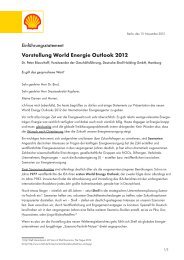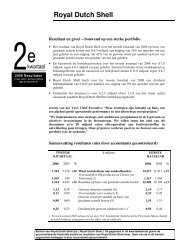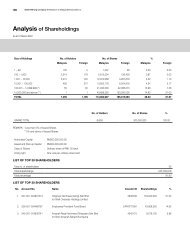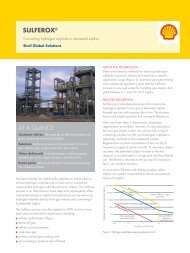ENVIRONMENTAL STATEMENT BARDOLINO DEVELOPMENT
ENVIRONMENTAL STATEMENT BARDOLINO DEVELOPMENT
ENVIRONMENTAL STATEMENT BARDOLINO DEVELOPMENT
Create successful ePaper yourself
Turn your PDF publications into a flip-book with our unique Google optimized e-Paper software.
Bardolino Development Environmental Statement<br />
factor likely to influence cetacean distribution is the availability of prey, mainly fish, plankton<br />
and cephalopods (Stone, 1997).<br />
Minke whales, white-beaked and white-sided dolphins, and harbour porpoises may occur<br />
regularly in the northern-central North Sea (Table 4.13). Killer, long-finned, pilot and sperm<br />
whales, and common, striped, Risso’s and bottlenose dolphins, are less frequently sighted in<br />
the northern-central North Sea. Other species, including northern bottlenose, Sowerby’s<br />
beaked, and fin and humpback whales, are encountered very infrequently (Hammond et al.,<br />
2002; Northridge et al., 1995; Reid et al., 2003; SMRU, 2001; Stone 1997, 1998, 2000, 2001,<br />
2003a and b; UKDMAP, 1998).<br />
Table 4.13 Sightings of cetaceans within Quadrant 22 and surrounding quadrants<br />
[Months in yellow indicate the proposed development schedule]<br />
Species J F M A M J J A S O N D<br />
Harbour porpoise<br />
White-beaked dolphin<br />
Minke whale<br />
White-sided dolphin<br />
Killer whale<br />
Common dolphin<br />
Source: UKDMAP (1998)<br />
Present within Quadrant 22 Present in surrounding Quadrants<br />
The harbour porpoise is the commonest cetacean in the North Sea (see Section 4.3.2).<br />
Highest densities in summer are found north of 56ºN, mostly in a north-south band between<br />
1ºE and 3°E. During the SCANS survey in the summer of 1994 there were an estimated<br />
268,000 porpoises in the North Sea. The northern and central areas of the North Sea appear<br />
to be important areas for harbour porpoises, especially in summer (SMRU, 2001).<br />
White-beaked dolphins are distributed over the continental shelf, and in the North Sea they<br />
tend to be more numerous within about 200 nm of the Scottish and north-eastern English<br />
coasts (Northridge et al., 1995). The abundance of white-beaked dolphins in the North Sea<br />
areas during the SCANS survey in the summer of 1994 was 7,856 (95% confidence interval<br />
4,000–13,300). This estimate includes shelf waters to the west of Shetland and Orkney<br />
(Hammond et al., 2002). White-beaked dolphins are present throughout the year in the North<br />
Sea, with most sightings recorded between June and October (Reid et al., 2003).<br />
Minke whales occur throughout the central and northern North Sea, particularly during the<br />
summer months (SMRU, 2001). There is no direct evidence that minke whales in the<br />
Northern Hemisphere migrate, but in some areas there appear to be shifts in latitudinal<br />
abundance with season (SMRU, 2001). This is true for the North Sea, where minke whales<br />
appear to move into the North Sea at the beginning of May and are present throughout the<br />
summer until October (Northridge et al., 1995). The estimated summer abundance of minke<br />
whales in North Sea areas during the SCANS 1994 survey was 7,200 (approximate 95%<br />
confidence interval 4,700 – 11,000). This estimate includes shelf waters to the west of<br />
Shetland and Orkney (Hammond et al., 2002). During the SCANS survey, the highest<br />
densities were recorded in the northwest North Sea, particularly off the mainland coast of<br />
Scotland (SMRU, 2001). It is apparent that the central and northern SEA-2 areas are<br />
important for minke whales in summer (SMRU, 2001).<br />
Killer whales have been observed throughout the northern North Sea in most months (SMRU,<br />
2001; Reid et al., 2003). Between Shetland and Norway, the species has been regularly<br />
recorded from November to March (Reid et al., 2003). Seasonal movements may be<br />
associated with particular prey, including seals and herring (Reid et al. 2003). An association<br />
of killer whales with oil platforms has been reported (SMRU, 2001).<br />
The Atlantic white-sided dolphin is primarily an offshore species but has been recorded during<br />
a number of surveys in the North Sea, especially during summer (Northridge et al., 1997;<br />
Reid et al., 2003). It shares most of its range with the white-beaked dolphin, but in the<br />
eastern North Atlantic it has a mainly offshore distribution and is consequently rarer than<br />
white-beaked dolphin over shelf waters (SMRU, 2001). Its presence in the North Sea is<br />
Page 4-28 April 2008


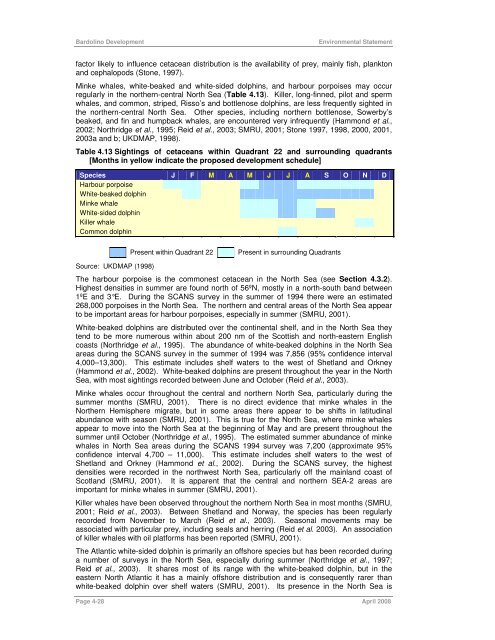

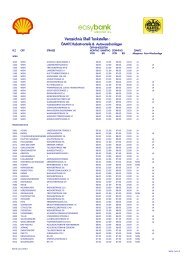
![Download Shell AutoGas Stationen [Stand: Januar 2013] (PDF](https://img.yumpu.com/9982753/1/190x245/download-shell-autogas-stationen-stand-januar-2013-pdf.jpg?quality=85)

